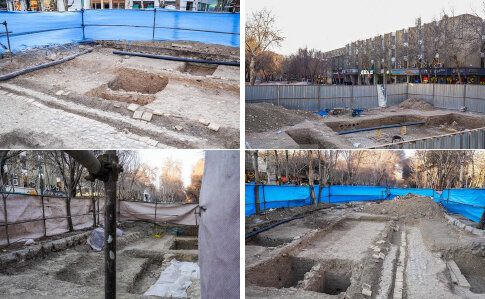Isfahan excavations bring to light relics dating from 4th-millennium BC onwards

TEHRAN – Newly-conducted excavations have yielded a fresh view over the olden days of Isfahan, a well-known historical tourism destination in central Iran.
The findings include brick paving textures, estimated to date from Qajar era (1789 to 1925) and Safavid era (1501 to 1736), potteries dating to Sassanid epoch (224 CE–651), as well as a significant number of animal bones and remains from [some] six thousand years ago, ISNA reported on Wednesday.
Led by Iranian archaeologist Mohsen Javari, the excavations were carried out in several points of Isfahan, which predominantly lies on its historical layers and texture.
The surveys have been conducted several trenches carved across the city’s Amadgah St., Enghelab Sq. and Chahar Bagh-e Abbasi St., the report said.
“Several waterways were discovered during an excavation done in an area opposite Amadgah Street. They were related to water division [mechanism] used in the Safavid era,” Javari said.
Commenting on the fate of the new discoveries, the archaeologist said, “Significant discoveries (relics), such as the one found opposite the Amadgah St. and ones found in Enghelab Sq. will go into the glass [cases] to go on display forever.”
“We are set to present information about these discoveries and their [associated] periods in multi-language texts accompanied by photographs so that passersby could learn about the history of the place while crossing the Chahar Bagh to answer their [probable] questions about history of the locale.”
Soaked in a rich history, Isfahan was once a crossroad of international trade and diplomacy in Iran and now it is one of Iran’s top tourist destinations for good reasons.
Experts say an ancient town, which lies partly beneath modern Isfahan, can be traced back to at least the Achaemenid era (559–330 BC), but little is known about the area before the rule of the Sassanid dynasty.
The modern city is filled with many architectural wonders such as unmatched Islamic buildings, bazaars, museums, Persian gardens and tree-lined boulevards. It's a city for walking, getting lost in its mazing bazaars, dozing in beautiful gardens, and meeting people.
Isfahan has long been nicknamed as Nesf-e-Jahan which is translated into “half the world”; meaning seeing it is relevant to seeing the whole world. In its heyday it was also one of the largest cities in the region with a population of nearly one million.
The cool blue tiles of Isfahan's Islamic buildings, and the city’s majestic bridges, contrast perfectly with the encircling hot, dry Iranian countryside. The UNESCO-registered Imam Square, best known as Naghsh-e Jahan Sq. (literary meaning “Image of the World”), was laid out under the reign of the Safavid ruler, Shah Abbas the Great, to signal the importance of Isfahan as a capital of his powerful empire.
Modern Isfahan is now home to some heavy industry, including steel factories and a nuclear facility on its outskirts, however its inner core wants to be preserved as a priceless gem.
AFM/MG
Leave a Comment